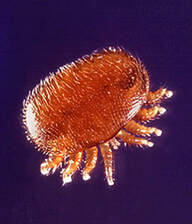|
The Honey Bee Health Coalition has fantastic resource for varroa management. Download the last version of Tools for Varroa Management and more (Check out the Integrated Pest Management spreadsheet tool!) on their website. You can also view the many helpful videos they have produced on YouTube. Why does this matter?
Every honey bee colony in the continental United States and Canada either has Varroa mites today or will have them within several months. Varroa mite infestation represents one of the greatest threats to honey bee health, honey production, and pollination services. When honey bee colonies are untreated or treated ineffectively colonies can fail and beekeepers can incur major economic losses, and, ultimately, agricultural food production may be impacted. In addition, colonies with Varroa are a source of mites that can spread to other colonies, even in other apiaries, through drifting, robbing, and absconding activity of bees. All beekeepers should remain vigilant to detect high Varroa mite levels and be prepared to take timely action in order to reduce mite loads. Effective mite control will reduce colony losses and avoid potential spread of infectious disease among colonies. Introduction: Randy Oliver on Small Cell Beekeeping One thing that bothers me is the vast amount of questionable beekeeping recommendations on the Web, and the fuzzy thinking behind some of the management advice being promoted to “save the bees.” Much of this advice is based upon wonderful idealism, or a fairy-tale version of Nature, or the anthropomorphizing of bee behavior. I, on the other hand, am a hard data kind of guy. I generally go out of my way in my articles to be non judgmental, and to keep my opinions to myself. The old saw goes that if you ask ten beekeepers how to do something, that you’ll get at least a dozen different answers. But simply believing that something’s gotta work doesn’t necessarily make it true in real life—I’ve heard many management suggestions that make complete sense when you first hear them, but upon deeper analysis run contrary to natural bee behavior, and often work against the bees! To me, the bottom line is, is the advocated method consistently successful? Does it result in healthy colonies that produce a harvestable honey crop, and then survive until the next season? Small cell foundation sure sounds like an easy and natural way to control varroa mites; regrettably, several scientific studies (reviewed in Seeley 2010) found that it had no effect! Despite its apparent lack of efficacy, some still cling to it as an article of “faith” (oh, that statement’s gonna tick some folk off!). Until I see a single controlled trial in which colony survival is better in the small cell group, I must remain skeptical. http://scientificbeekeeping.com/the-rules-redux/ Thomas Seeley, Sean Grin. Small-cell comb does not control Varroa mites in colonies of honeybees of European origin. Apidologie, Springer Verlag, 2011, 42 (4), pp.526-532. <10.1007/s13592-011-0054-4>. <hal-01003589>
Dewey Caron. Tools for Varroa management, a guide for effective varroa sampling & control. Honey Bee Health Coalition (2015). Jennifer A. Berry, William B. Owens, Keith S. Delaplane. Small-cell comb foundation does not impede Varroa mite population growth in honey bee colonies. Apidologie 41 (2010) 40–44, DOI: 10.1051/apido/2009049. AM Ellis, GW Hayes, JD Ellis. The efficacy of small cell foundation as a varroa mite (Varroa destructor) control. Exp Appl Acarol (4): 311-6. doi 10.1007/s10493-008-9221-3 (Epub 2008 Dec6). Francis Saucy. On the natural cell size of European honey bees: A "fatal error" or distortion of historical data? (Journal of Apicultural Science (Impact Factor: 1). 07/2014; 53(3):327-336. DOI: 10.3896/IBRA.1.53.3.01. A useful video from the folks at Brushy Mountain Bee Farm: Published on Mar 18, 2016
With its high efficacy and low risk of contamination, many beekeepers are looking to use Oxalic Acid this year. We have brought in an expert panelist, Marion Ellis Ph.D, to better explain the use of Oxalic Acid. As an entomologist, his research into the effects of Varroa and other parasites on honey bee colonies have given beekeepers insight into better hive management. "I particularly like this method because, as you can see, there are mites lying on their backs kicking their legs and really suffering, and it really makes me feel good to see that." At 10 minutes, 30 seconds in http://tinyurl.com/joae7tx This idea was stolen, fair & square, from Randy Oliver. Folks living outside of Boise might want to follow the methodology in the ScientificBeekeeping.com article instead of using this chart. The graph illustrates the treatment periods in color. Light blue is the thymol application period, formic acid is pink and hop beta acids are shown on the tails of the calendar during the broodless period. In the case of thymol, the dates assume that thymol is on for 4 weeks and the supers can go on right after the product is removed, per the label. Formic acid is bounded by temps. The color areas show the application period, and the dates assume a three week application window. The application period is only 7 days. This may be a little obtuse. Check it out and send any questions. The intent here is that we can have a tool for the beginning beeks to use when trying to figure out when and with what to treat for that despicable, nasty varroa mite.
|
|||||||
|
Mailing Address
Treasure Valley Beekeepers Club PO Box 5066 Boise, Idaho 83705-0066 |
|


